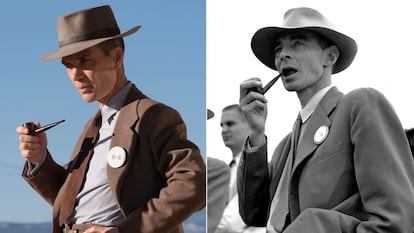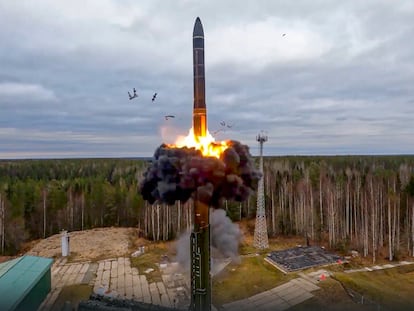A new Cold War? The nuclear threat resurfaces in books, series and movies
Numerous works reflect the similarities of the current geopolitical situation with the Cold War era in parallel to the Russian invasion of Ukraine

The screen is filled by a scientist who, with eyes like light bulbs in all their electrical splendor, seems to question himself beyond time. He is Robert Oppenheimer, who 48 years after dying of throat cancer — he drank and smoked too much, doctors warned him — has provided the cultural reference point for months. Christopher Nolan, director and screenwriter of the movie Oppenheimer, which won seven Oscars, said in an interview that the American physicist was the most important man of the 20th century because through him, mankind gained the ability to blow up the entire planet.
The spectacular notoriety of his scientific vicissitudes, the political betrayals and the tangled web of Soviet espionage experienced by the New York researcher and his Manhattan Project team has surprised many. After all, it is a film for adults in a time of superhero franchises, a long, dark journey with no possible happy ending and which dissects a deadly serious matter.
One of the keys to its success is perhaps that it links fatally with the present day, when the war between Russia and Ukraine, the conflict in the Middle East, and the tensions between the United States and China over Taiwan bring back a certain air of the Cold War and its arms escalation. Vladimir Putin has for some time been threatening to unleash a nuclear conflict and just this month United Nations Secretary General António Guterres warned of rising geopolitical tensions, saying that humanity cannot survive “a sequel of Oppenheimer.”

These are shadowy echoes of the past being renewed in the present. “Yes, being very different times, I would say there is a certain revival of the Cold War. The idea of rearmament and the tension of balance, the fear of entering into a direct confrontation, reaching a level of brutal destruction,” reflects Mariano Aguirre, author of Guerra Fría 2.0 (Cold War 2.0). In his book, Aguirre makes note of the great differences between eras — nowadays the struggles between countries are between different types of capitalism, without a trace of socialism or communism and between a fragmentary multilateralism of blocs, more complex than the U.S. vs the USSR equation of yesteryear — but he underlines certain similarities between the period 1947-1991 and the present day. There are processes of escalation and rearmament, the indirect confrontation between superpowers with atomic capability, proxy wars (as in the case of Ukraine), brutal repression of civil liberties in Russia, and a certain air of cultural cancellation in the West if one questions, for example, the expansion of NATO’s area of influence.
Aguirre, an associate member of the London-based Chatham House think tank, also highlights similarities in the growing importance of the art of diplomacy, closed-door negotiations and contacts, hostage exchanges, or the influential role of certain media. Examples of this would be the exchange of the women’s NBA superstar Brittney Griner for a Russian arms dealer, the current situation of The Wall Street Journal reporter Evan Gershkovich, accused of espionage and imprisoned for a year in Russia, or the case of the United States leaking to the media that diplomatic sources had already warned Putin’s government about the possibility of attacks in the Russian capital before the massacre at the Crocus City Hall, northwest of Moscow.

You and the Atom Bomb
It was George Orwell who first spoke of the concept of the Cold War as a radical geopolitical shift, because of the possibility of mutual self-destruction brought about by the development of the atomic bomb. He wrote about the subject in an article published on October 19, 1945, in Tribune magazine. In his essay, You and the Atom Bomb, Orwell warns that living in the shadow of the nuclear threat “is a peace that is no peace,” but a new war landscape he called the Cold War, which now seems to be revived again.
This atmosphere is related in public reports, non-fiction books and novels. In 2023, the Brussels think tank Bruegel warned that we were heading toward a new Cold War between two large blocs led, respectively, by the United States, the hegemonic power, and China, the emerging one. For their part, researchers at the Royal United Services Institute detect that Russia is rekindling some of the methods of the 1970s and 1980s, involving clean agents on long-term espionage missions — so dear to Moscow since the Soviet era — as was the case with the theft of atomic secrets by Klaus Fuchs, a member of the Manhattan Project. And from Spain’s Elcano Royal Institute, analyst Jesús A. Núñez Villaverde warns that the latest moves NATO seems to be planning “take us back to times we mistakenly thought we had overcome, with the only exception being that, if previously we were talking about the European Union, now we are talking about Russia.”

Reality and fiction
That old icy air is also being revived in video games, television series and movies. The Call of Duty videogame franchise is enjoying success with Call of Duty; Black Ops Cold War, set in 1981, where two of the game’s characters are Ronald Reagan and Mikhail Gorbachev, and the protagonist is an alleged Soviet spy trying to steal U.S. nuclear secrets. On the streaming platforms is the documentary series Turning Point: The Bomb and the Cold War (Netflix, 2024), which across nine episodes narrates how close the world came to a nuclear apocalypse in the 1960s. As for possible fictional apocalypses, Oppenheimer’s 2023 release was joined by Wes Anderson’s Asteroid City, which won the Palme d’Or at Cannes, and is set in the 1950s in the context of nuclear testing in the U.S. desert near the Mexican border.
“On August 6, 1945, in the blink of an eye, the world changed completely. That had a full impact on popular culture and on comics,” reflects cultural analyst Giovanni Pasco, who specializes in the sociopolitical reading of comics. He emphasizes that after 1945 in the United States, highly politicized superhero figures emerged, fully involved in the present war of the atomic bomb and its consequences on the planet: The Fantastic Four were a family exposed to cosmic rays in a rocket when they were racing to beat the communists in the space race; The Incredible Hulk was a scientist accidentally exposed to gamma rays during a test; Spiderman was a boy bitten by a radioactive spider and The Watchmen exemplifies a dystopian fiction that harkens back to the Cold War era, where the world is constantly on the brink of nuclear disaster. And it’s not just about the past or future, but the present: these are all superheroes that to this day are being transmuted into movies or series.
Perhaps the Cold War never quite died down. After the 246,000 civilians killed by the Little Boy and Fat Man bombs dropped on Hiroshima and Nagasaki in August 1945, after the decades-long psychological confrontation between the Soviet Union and the United States led the U.S. Civil Defense Service to broadcast radio and television spots on how to behave in case of a Soviet attack (with the voices and faces of Johnny Cash, Groucho Marx, and Boris Karloff), the fear of the bomb and its geopolitical consequences has resurfaced.
Barbara Moran, an American science writer and author of The Day We Lost the H-bomb (2009), about the nuclear accident in Palomares, Spain, believes that the cultural preoccupation with the bomb is changing over time. Before, in the movies, “maybe there was fear of radiation, mutations, and nuclear destruction,” she says, while now people seem to be more “concerned about human weakness, betrayal, and political consequences.”
Regarding the world’s current political leaders, it so happens that their ties to the Cold War era are very close. “For better or for worse, Joe Biden was trained in those times and knows very well the potential dangers of confrontation between nuclear powers, and Putin was molded as a spy in the final years of the Cold War, in the times of the decline and disappearance of the USSR,” Aguirre notes.
Against all odds, the intrigues between spies and the nuclear threat are once again topical. It is something that seems from another time, from another world. As the secret agent John Preston, played by Michael Caine in the movie The Fourth Protocol (1987) says to the different heads of the secret services, in the face of their conspiracies in the heat of atomic danger: “It’s about time they put you in a fucking museum.”
Sign up for our weekly newsletter to get more English-language news coverage from EL PAÍS USA Edition
Tu suscripción se está usando en otro dispositivo
¿Quieres añadir otro usuario a tu suscripción?
Si continúas leyendo en este dispositivo, no se podrá leer en el otro.
FlechaTu suscripción se está usando en otro dispositivo y solo puedes acceder a EL PAÍS desde un dispositivo a la vez.
Si quieres compartir tu cuenta, cambia tu suscripción a la modalidad Premium, así podrás añadir otro usuario. Cada uno accederá con su propia cuenta de email, lo que os permitirá personalizar vuestra experiencia en EL PAÍS.
¿Tienes una suscripción de empresa? Accede aquí para contratar más cuentas.
En el caso de no saber quién está usando tu cuenta, te recomendamos cambiar tu contraseña aquí.
Si decides continuar compartiendo tu cuenta, este mensaje se mostrará en tu dispositivo y en el de la otra persona que está usando tu cuenta de forma indefinida, afectando a tu experiencia de lectura. Puedes consultar aquí los términos y condiciones de la suscripción digital.
More information
Archived In
Últimas noticias
Maduro pleads not guilty before the federal court in New York: ‘I am still the president of Venezuela’
A new test can detect Alzheimer’s from a finger prick
UN team enters Sudanese city of El Fasher after paramilitary massacre: ‘It’s like a ghost town’
A recipe for resistance: Indigenous peoples politicize their struggles from the kitchen
Most viewed
- Gilles Lipovetsky: ‘If you want to live better and fall in love, take Prozac, don’t look to philosophy’
- Alain Aspect, Nobel laureate in physics: ‘Einstein was so smart that he would have had to recognize quantum entanglement’
- Alvin Hellerstein, a 92-year-old judge appointed by Bill Clinton, to preside over Maduro’s trial in New York
- Why oil has been at the center of Venezuela-US conflicts for decades
- Maduro’s downfall puts China’s relationship with Venezuela to the test











































